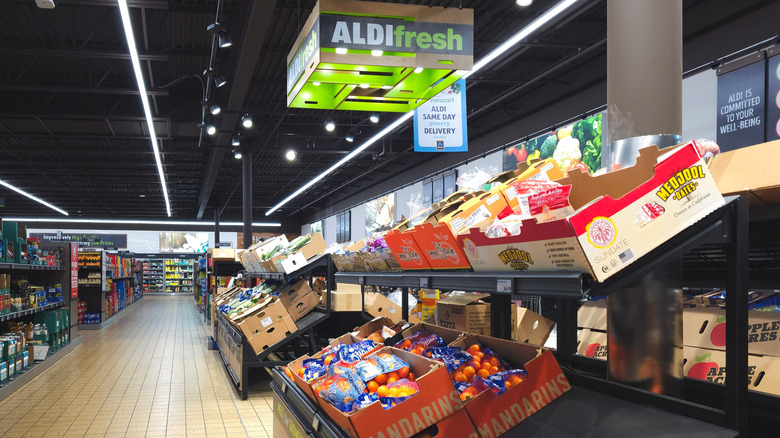Here's What 'Aldi' Actually Means
Trying to guess where the name Aldi came from would probably make for a fun parlor game. The four simple capital letters in the logo might make you wonder if it was an acronym of some sort, the meaning of the letters long forgotten, just as they were with IBM, formerly known as International Business Machines. If someone clued you in to the fact that the business was built by two brothers, you might wonder if it was a portmanteau formed from their first names, but the names Karl and Theo just don't match up.
You could go in search of a German dictionary — the company did start in Germany — looking for the meaning of the word "aldi," but you'd come up empty. Ready to give up? The name is a shortened form of the business's original name, Albrecht Diskont; Albrecht was the brothers' last name, and diskont (discount in English), to demonstrate the family's early commitment to low prices.
Ironically, the decision to give the company a unified brand name came in 1962, just as the brothers agreed to amicably split the company into two separate entities — Aldi Nord and Aldi Sud — after a dispute over whether or not to sell cigarettes. The brothers split Germany in half, with Theo taking control over the northern part of the country, and Karl taking over the southern. Eventually, both companies expanded globally. Aldi Sud operates all of the Aldi brand stores in the United States, along with stores in Australia, China, Ireland, the United Kingdom, and, through its Austrian subsidiary Hofer AG, some European countries. Aldi Nord operates largely in Europe and, it might surprise you to learn, is the owner of Trader Joe's.
Staying true to the discount part of the name
The one thing the brothers seemed to always agree on was the need to stay true to the "diskont" part of the name. The Albrechts took over the grocery store started in 1913 by their mother Anna Albrecht in Essen, West Germany, upon their return from World War II, a time when Germans were economically strapped. To keep their prices low, the brothers offered all customers a 3% discount – the same amount that people could ultimately receive as a rebate, after paying full price, at other stores.
Aldi was also able to keep its prices low – then and now — with a narrow product range and by operating stores with a smaller footprint than most other supermarkets. The stores' small footprint allows the company to keep rent, energy costs, and employees to a minimum. It is also able to negotiate lower prices from its suppliers. Aldi is now more affordable than Walmart as well as Trader Joe's. In addition, after 60-plus years as separate entities, the two Aldi companies are now said to be in talks to merge, although neither company has confirmed the reports. Once reunited, will the companies return to the family name? Perhaps that's another parlor game in the making.


